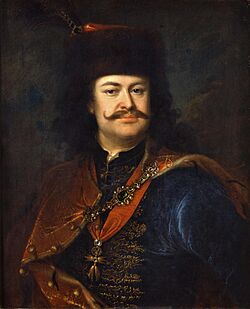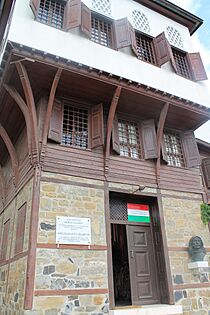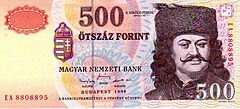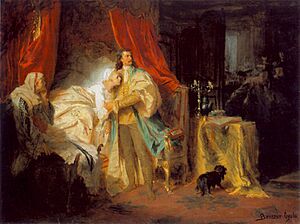Francis II Rákóczi facts for kids
Quick facts for kids Francis II Rákóczi |
|
|---|---|
| Prince of Transylvania, Ruling Prince of Hungary in wartime | |

Francis II Rákóczi (painted by Ádám Mányoki)
|
|
| Prince of Transylvania | |
| Reign | 1704 – 1711 |
| Predecessor | Leopold I |
| Successor | Charles IV |
| Born | 27 March 1676 Borsi, Royal Hungary (now Borša, Slovakia) |
| Died | 8 April 1735 (aged 59) Tekirdağ, Ottoman Empire |
| Burial | 1906 St. Elisabeth Cathedral, Kassa, Kingdom of Hungary (now Košice, Slovakia) |
| Spouse | Sarolta Amália (Charlotte Amalie of Hesse-Wanfried) |
| Issue |
|
| House | Rákóczi |
| Father | Francis I Rákóczi |
| Mother | Ilona Zrínyi |
| Signature |  |
Francis II Rákóczi (born March 27, 1676 – died April 8, 1735) was a very important Hungarian nobleman. He led a big fight for freedom, known as Rákóczi's War of Independence, against the Habsburg rulers from 1703 to 1711. During this time, he was the "Ruling Prince" of Hungary. He was also the Prince of Transylvania, a region in Eastern Europe. Today, many people in Hungary see him as a national hero.
Even though the Hungarian parliament wanted to make him king, he said no. He chose the title "Ruling Prince of Hungary" instead. This showed that he wasn't fighting for his own power, but for Hungary's freedom from the Habsburg family.
Contents
Early Life and Family
Francis II Rákóczi was born into one of the richest and most powerful families in the Kingdom of Hungary. He was the third child of Francis I Rákóczi and Ilona Zrínyi. His father had been chosen as the ruling prince of Transylvania. His mother was the daughter of Petar Zrinski, a Croatian leader.
Sadly, Francis's father died when he was only four months old. His older brother, George, had also died as a baby. Francis had an older sister named Julianna. His grandfathers and great-grandfathers were also important princes of Transylvania.
After his father passed away, his mother, Ilona Zrínyi, wanted to take care of her children. However, the Emperor Leopold I insisted on being their guardian. Despite this, Ilona raised Francis and Julianna in their family castles, especially the Munkács Castle. Francis loved this castle very much throughout his life.
Growing Up Under Imperial Control
When Francis was young, his mother married Imre Thököly, another Hungarian leader who was fighting the Habsburgs. Thököly was very busy with his own political struggles and didn't focus much on Francis's education.
In 1686, the Habsburg army surrounded Munkács Castle. Francis's mother, Ilona Zrínyi, bravely defended the castle for three years! But in 1688, she had to give up. Francis and his sister then became wards of Emperor Leopold I and moved to Vienna. They got their family lands back, but they couldn't leave Vienna without the Emperor's permission.
When Francis was 17, the Emperor allowed him to manage his own property. His sister, Julianna, who had married a powerful Austrian general, helped him. In 1694, Francis married Princess Charlotte Amalie of Hesse-Wanfried when she was 15 years old. They moved to his family castle in Sárospatak, where he began to look after his large estates.
The Fight for Freedom Begins
After a peace treaty in 1699, Francis's stepfather, Imre Thököly, and his mother, Ilona Zrínyi, had to leave Hungary. Francis stayed in Vienna, still watched by the Emperor.
Some former peasant soldiers, who had fought with Thököly, started a new uprising in a region called Hegyalja, which was part of Rákóczi's land. They took over some castles and asked Francis to lead them. At first, he wasn't sure, as it seemed like a small peasant revolt. He quickly went back to Vienna to show he wasn't involved.
Francis then became good friends with Miklós Bercsényi, another rich and important Hungarian nobleman. Bercsényi was also related to many noble families.
The Rákóczi Uprising
At this time, the Habsburg family was facing problems in Spain, and France wanted to weaken them. So, France contacted Rákóczi and offered to help if he fought for Hungarian independence. But an Austrian spy found out about their letters and told the Emperor.
Because of this, Rákóczi was arrested on April 18, 1700, and put in prison. It looked like he might be sentenced to death, just like his grandfather. But with the help of his pregnant wife and the prison guard, Rákóczi managed to escape! He fled to Poland. There, he met Bercsényi again, and they continued talking with the French.
Three years later, many Austrian soldiers left Hungary to fight in another war. Seeing this chance, some Hungarian fighters, called Kuruc, started a new uprising. They asked Rákóczi to lead them. He decided it was time to fight for his country's freedom and accepted. On June 15, 1703, about 3,000 armed men joined him. Bercsényi also arrived with money from France and Polish soldiers.
Most Hungarian noble families didn't support Rákóczi at first because they thought it was just a peasant rebellion. But Rákóczi convinced many Hajduk (Hungarian peasant warriors) to join his side. By late 1703, his forces controlled most of Hungary east and north of the Danube River.
The Austrians were fighting on many fronts, so they started talking about peace with Rákóczi. However, in August 1704, the Austrians and British won a big battle against France and Bavaria. This made the Austrians stronger and stopped Rákóczi's forces from joining their French allies.
This put Rákóczi in a tough spot. France's help decreased, and he needed a bigger army to hold the land he had won. It was also hard to get enough weapons and food for his soldiers. He tried to solve this by making new copper coins, but people were used to silver coins and didn't trust them. Even so, Rákóczi kept fighting well for a while, but after 1706, his army started to lose ground.
Leading the Nation
In September 1705, a meeting of Hungarian leaders, called the Diet, chose Rákóczi to be the "Ruling Prince" of Hungary. They also created a 24-member Senate to help him. Rákóczi and the Senate were in charge of talking with other countries and making peace.
With encouragement from England and the Netherlands, peace talks between Hungary and the Emperor started again in October 1705. Both sides changed their plans depending on how the war was going. One big problem was who would rule Transylvania – neither side wanted to give it up.
Rákóczi felt that declaring Hungary's full independence would make other countries more willing to negotiate with him. In 1706, his wife and sister tried to help with peace talks, but Rákóczi didn't accept their efforts because he didn't trust the Emperor.
On June 13, 1707, at Rákóczi's suggestion, the Diet declared that the House of Habsburg was no longer the ruler of Hungary. But this didn't help much. The copper money still wasn't popular, and Louis XIV of France refused to make official agreements with Rákóczi, leaving Hungary without strong allies. An alliance with Imperial Russia also didn't happen.
A big defeat for Rákóczi's army happened at the Battle of Trencsén on August 3, 1708. Rákóczi's horse fell, and he was knocked out. His soldiers thought he was dead and ran away. This loss was a major blow to the uprising. Many Hungarian leaders then switched sides, hoping the Emperor would forgive them. Rákóczi's forces became much smaller, only controlling areas around Munkács.
Not trusting the Emperor's envoy, Rákóczi left Hungary for Poland on February 21, 1711.
Peace and Exile
After Rákóczi left, Sándor Károlyi became the new leader of the Hungarian forces. He quickly made a peace deal with the Emperor's representative. On May 1, 1711, about 12,000 rebels gave up their weapons and promised loyalty to the Emperor.
The peace agreement, called the Peace of Szatmár, was not too harsh on Rákóczi. He was promised forgiveness if he swore loyalty to the Emperor, and he could move to Poland if he wanted. But Rákóczi didn't accept these terms. He didn't trust the Habsburgs and didn't think the peace treaty was valid because it was signed after Emperor Joseph I had died. Because he refused, his Hungarian properties, including Munkács Castle and 200 villages, were taken away from him.
Life in Exile
Rákóczi was offered the Polish Crown twice by the Russian Tsar Peter I of Russia, but he turned it down. He stayed in Poland until 1712, treated as an honored guest by the Polish nobles. For a while, he lived in Gdańsk using a fake name.
On November 16, 1712, he left Poland and went to England. But Queen Anne of Britain, pressured by the Habsburgs, refused to meet him. So, Rákóczi went to France, arriving on January 13, 1713. He asked Louis XIV to remember Hungary during the peace talks for the War of the Spanish Succession. However, the peace treaties signed in 1713 and 1714 didn't mention Hungary or Rákóczi at all. Even his two sons, who were being watched in Vienna, were not allowed to join him.
Even though France didn't officially recognize him, Prince Rákóczi was well-liked at the French court. But after Louis XIV died in 1715, Rákóczi decided to accept an invitation from the Ottoman Empire (Turkey), which was still fighting the Habsburgs. He left France in September 1717 with about 40 people and arrived in Gallipoli on October 10, 1717. He was welcomed, but his idea of leading a Christian army to fight the Habsburgs wasn't taken seriously.

The Ottoman Empire signed a peace treaty with Austria in 1718. One part of the treaty said that the Turks would not hand over the Hungarian exiles. Two years later, Austria asked for the exiles, but the Sultan refused, saying it was a matter of honor. Rákóczi and his group settled in the town of Tekirdağ (called Rodostó in Hungarian), which was far from the Ottoman capital. A large group of Hungarians grew around this town by the Sea of Marmara. Many of his friends and fellow exiles joined him there.
Rákóczi lived in Tekirdağ for 18 years. He had a daily routine: waking up early, going to church, reading and writing in the mornings, and doing carpentry in the afternoons. His son, György Rákóczi, sometimes visited him. In 1733, new troubles in Poland gave him hope of returning to Hungary, but it didn't happen. Francis II Rákóczi died on April 8, 1735, at 59 years old.
In his will, Rákóczi left things to his family and fellow exiles. He also wrote letters asking the Sultan and France's ambassador to remember his friends in exile. His body was buried in the French church of Saint-Benoît in Istanbul, next to his mother, Ilona Zrínyi.
Much later, on October 29, 1906, his remains were moved to the St. Elisabeth Cathedral in Košice, which was then in Hungary (now in Slovakia). He is buried there with his mother and his son.
Family Life
On September 26, 1694, in Cologne, Francis married Princess Charlotte Amalie of Hesse-Wanfried. She was 15 years old and from a German noble family. They had four children:
- Lipót Lajos György Rákóczi (1696-1699)
- József Rákóczi, Duke of Munkács (1700-1738). He never married but had a daughter.
- György Rákóczi, Duke of Makovica (1701-1752). He married twice and had one son.
- Sárolta Rákóczi (1706-1706)
Key Moments in His Life
Here's a quick look at important dates in Francis II Rákóczi's life:
- Early Life
- March 27, 1676 – Francis Rákóczi is born.
- January 26, 1699 – The Treaty of Karlowitz forces his stepfather and mother into exile.
- February 11, 1701 – Talks begin with Louis XIV about Hungary's fight for freedom.
- February 1701 – Rákóczi is arrested but escapes from prison.
- The War of Independence
- June 15, 1703 – Rákóczi meets Tamás Esze and his army, starting the uprising.
- September 26, 1703 – A large part of Hungary is under Rákóczi's control.
- August 13, 1704 – The Habsburgs defeat the French-Bavarian army, weakening Rákóczi's allies.
- May 15, 1705 – Emperor Leopold I dies; Joseph I becomes Emperor.
- September 20, 1705 – The Hungarian Diet declares Rákóczi the Ruling Prince.
- October 27, 1705 – Peace talks begin.
- June 13, 1707 – The Diet declares the Habsburg family is no longer the ruler of Hungary.
- End of the War, Peace Treaty
- August 3, 1708 – Rákóczi's forces are defeated at the Battle of Trencsén.
- February 21, 1711 – Rákóczi goes into exile.
- May 1, 1711 – Hungarian forces surrender near Szatmár.
- Exile
Remembering Francis II Rákóczi
Francis II Rákóczi is a very important national hero in Hungary, and he is remembered in many ways today.
Memorials and Statues



A large statue of him on horseback stands in front of the Hungarian Parliament Building in Budapest. It has his famous motto: "Cum Deo Pro Patria et Libertate" which means "With God for Fatherland and Liberty".
After 1945, when statues of Habsburg kings were removed from the Millennium Monument in Heroes' Square, a new statue of Rákóczi was put in their place.
Places and Institutions
Many places in Hungary are named after Rákóczi. In Budapest, there are 11 Rákóczi streets and 3 Rákóczi squares, including a very important avenue called Rákóczi út ("Rákóczi Avenue"). This street was named after him in 1906 when his remains were brought back to Hungary.
There's also a bridge over the Danube River in Budapest called the Rákóczi Bridge. Two villages in Hungary, Rákóczifalva and Rákócziújfalu, are named after him.
The library in Miskolc is also named the "II. Rákóczi Ferenc County Library" in his honor. The house where he lived in Tekirdağ, Turkey, has been turned into the Rákóczi Museum, Tekirdağ, which visitors can explore.
Money and Music

You can find Rákóczi's picture on Hungarian money. He used to be on the 50-forint banknote, and now he is on the 500-forint note.
A famous patriotic song from the 1700s and 1800s is called the Rákóczi March. It was thought to be his favorite tune. Famous composers like Hector Berlioz and Franz Liszt used this march in their music. The Rákóczi March is still played at Hungarian national and military celebrations today.
Images for kids
-
Histoire des Révolutions de Hongrie, The Hague, by Jean Neaulme, 1739





